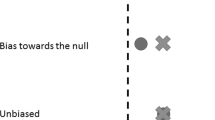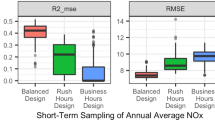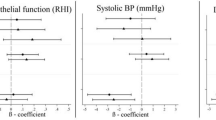Abstract
This paper describes a modeling framework for estimating the acute effects of personal exposure to ambient air pollution in a time series design. First, a spatial hierarchical model is used to relate Census tract-level daily ambient concentrations and simulated exposures for a subset of the study period. The complete exposure time series is then imputed for risk estimation. Modeling exposure via a statistical model reduces the computational burden associated with simulating personal exposures considerably. This allows us to consider personal exposures at a finer spatial resolution to improve exposure assessment and for a longer study period. The proposed approach is applied to an analysis of fine particulate matter of <2.5 μm in aerodynamic diameter (PM2.5) and daily mortality in the New York City metropolitan area during the period 2001–2005. Personal PM2.5 exposures were simulated from the Stochastic Human Exposure and Dose Simulation. Accounting for exposure uncertainty, the authors estimated a 2.32% (95% posterior interval: 0.68, 3.94) increase in mortality per a 10 μg/m3 increase in personal exposure to PM2.5 from outdoor sources on the previous day. The corresponding estimates per a 10 μg/m3 increase in PM2.5 ambient concentration was 1.13% (95% confidence interval: 0.27, 2.00). The risks of mortality associated with PM2.5 were also higher during the summer months.
This is a preview of subscription content, access via your institution
Access options
Subscribe to this journal
Receive 6 print issues and online access
$259.00 per year
only $43.17 per issue
Buy this article
- Purchase on Springer Link
- Instant access to full article PDF
Prices may be subject to local taxes which are calculated during checkout

Similar content being viewed by others
References
Pope III C.A., and Dockery D.W. Health effects of fine particulate air pollution: lines that connect. J Air Waste Manag Assoc 2006: 56: 709–742.
Gotschi T., Heinrich J., Sunyer J., and Kunzli N. Long-term effects of ambient air pollution on lung function: a review. Epidemiology 2008: 19: 690–701.
Katsouyanni K., Samet J.M., Anderson H.R., Atkinson R., Le Tertre A., and Medina S., et al. Air pollution and health: a European and North American approach (APHENA). Res Rep Health Eff Inst 2009: 142: 5–90.
Dockery D.W. Health effects of particulate air pollution. Ann Epidemiol 2009: 11: 257–263.
Avery C.L., Mills K.T., Williams R., McGraw K.A., Poole C., and Smith R.L., et al. Estimating error in using ambient PM2.5 concentrations as proxies for personal exposures: a review. Epidemiology 2010: 21: 215–223.
Sarnat J.A., Wilson W.E., Strand M., Brook J., Wyzga R., and Lumley T. Panel discussion review: session 1—exposure assessment and related errors in air pollution epidemiologic studies. J Expo Sci Environ Epidemiol 2007: 17: S75–S82.
Dominici F., Zeger S.L., and Samet J.M. A measurement error model for time-series studies of air pollution and mortality. Biostatistics 2000: 1: 157–175.
Janssen N.A., Schwartz J., Zanobetti A., and Suh H.H. Air conditioning and source-specific particles as modifiers of the effects of PM10 on hospital admission for heart and lung disease. Environ Health Perspect 2002: 110: 43–49.
Bell M.L., Ebisu K., Peng R.D., and Dominici F. Adverse health effects of particulate air pollution: modification by air conditioning. Epidemiology 2009: 20: 682–686.
Ozkaynak H., Xue J., Spengler J., Wallace L., Pellizzari E., and Jenkins P. Personal exposure to airborne particles and metals: results from the Particle TEAM study in Riverside, California. J Expo Anal Environ Epidemiol 1996: 6: 57–78.
Williams R., Suggs J., Creason J., Rodes C., Lawless P., and Kwok R., et al. The 1998 Baltimore Particulate Matter Epidemiology-Exposure Study: part 2. Personal exposure assessment associated with an elderly study population. J Expo Anal Environ Epidemiol 2000a: 10: 533–543.
Williams R., Suggs J., Zweidinger R., Evans G., Creason J., and Kwok R., et al. The 1998 Baltimore Particulate Matter Epidemiology-Exposure Study: part 1. Comparison of ambient, residential outdoor, indoor and apartment particulate matter monitoring. J Expo Anal Environ Epidemiol 2000b: 10: 518–532.
McBride S.J., Williams R.W., and Creason J. Bayesian hierarchical modeling of personal exposure to particulate matter. Atmos Environ 2007: 41: 6143–6155.
McCurdy T., Glen G., Smith L., and Lakkadi Y. The national exposure research laboratory's consolidated human activity database. J Expo Anal Environ Epidemiol 2000: 10: 566–578.
Zidek J., Shaddick G., White R., Meloche J., and Chat eld C. Using a probabilistic model (pCNEM) to estimate personal exposure to air pollution. Environmetrics 2005: 16: 481–493.
US EPA. Total Risk Integrated Methodology TRIM.Expo Inhalation User's Document Volume I: Air Pollutants Exposure Model (APEX, version 3) User's Guide 2003.
Burke J.M., Zufall M.J., and Ozkaynak H. A population exposure model for particulate matter: case study results for PM2.5 in Philadelphia, PA. J Expo Anal Environ Epidemiol 2001: 11: 470–489.
Holloman C.H., Bortnick S.M., Morara M., Strauss W.J., and Calder C.A. A Bayesian hierarchical approach for relating PM2.5 exposure to cardiovascular mortality in North Carolina. Environ Health Perspect 2004: 112: 1282–1288.
Calder C.A., Holloman C.H., Bortnick S., Strauss W., and Morara M. Relating ambient particulate matter concentration levels to mortality using an exposure simulator. J Am Stat Assoc 2008: 103: 137–148.
Blangiardo M., Hansell A., and Richardson S. A Bayesian model of time activity data to investigate health effect of air pollution in time series studies. Atmos Environ 2011: 45: 379–386.
Shaddick G., Lee D., Zidek J.V., and Salway R. Estimating exposure response functions using ambient pollution concentrations. Ann App Sta 2008: 2: 1249–1270.
Reich B.J., Fuentes M., and Burke J. Analysis of the effects of ultrafine particulate matter while accounting for human exposure. Environmetrics 2008: 20: 131–136.
Berrocal V.J., Gelfand A.E., Holland D.M., Burke J., and Miranda M.L. On the use of a PM2.5 exposure simulator to explain birthweight. Environmetrics 2011: 22: 553–571.
Long C.M., Suh H.H., and Koutrakis P. Characterization of indoor particle sources using continuous mass and size monitors. J Air Waste Manag Assoc 2000: 50: 1236–1250.
Ivy D., Mulholland J.A., and Russell A.G. Development of ambient air quality population-weighted metrics for use in time-series health studies. J Air Waste Manag Assoc 2008: 58: 711–720.
Strickland M.J., Darrow L.A., Mulholland J.A., Klein M., Flanders W.D., and Winquist A., et al. Implications of different approaches for characterizing ambient air pollutant concentrations within the urban airshed for time-series studies and health benefits analyses. Environ Health 2011: 10: 36.
McMillan N.J., Holland D.M., Morara M., and Feng J. Combining numerical model output and particulate data using Bayesian space-time modeling. Environmentrics 2009: 21: 48–65.
Byun D.J., and Schere K.L. Review of the governing equations, computational algorithms, and other components of the Models-3 Community Multiscale Air Quality (CMAQ) modeling system. Appl Mech Rev 2006: 59: 51–77.
Cao Y., and Frey H.C. Assessment of inter-individual and geographic variability in human exposure to fine particulate matter in environmental tobacco smoke. Risk Anal 2011a: 31: 578–591.
Cao Y., and Frey H.C. Geographic differences in inter-individual variability of human exposure to fine particulate matter. Atmos Environ 2011b: 45: 5684–5691.
Liu X., and Frey H.C. Modeling of in-vehicle human exposure to ambient fine particulate matter. Atmos Environ 2011: 45: 4745–4752.
Koontz M.B., and Rector H.E. Estimation of distribution of residential air exchange rates (Report #600R95180). U.S. Environmental Protection Agency, 1995.
Murray D.M., and Burmaster D.E. Residential air exchange-rates in the United States empirical and estimated parametric distributions by season and climatic region. Risk Anal 1995: 15: 459–465.
Weisel C.P., Zhang J., Turpin B.J., Morandi M.T., Colome S., and Stock T.H., et al. Relationships of Indoor, Outdoor, and Personal Air (RIOPA). Part I. Collection methods and descriptive analyses. Res Rep Health Eff Inst 2005: 130: 1–107; discussion 109–127.
Schwartz J. The distributed lag between air pollution and daily deaths. Epidemiology 2000: 11: 320–326.
Samet J.M., Dominici F., Curriero F.C., Coursac I., and Zeger S.L. Fine particulate air pollution and mortality in 20 U.S. cities, 1987–1994. N Engl J Med 2000: 343: 1742–1749.
Peng R.D., and Bell M.L. Spatial misalignment in time series studies of air pollution and health data. Biostatistics 2010: 11: 720–740.
Peng R.D., Dominici F., Pastor-Barriuso R., Zeger S.L., and Samet J.M. Seasonal analyses of air pollution and mortality in 100 US cities. Am J Epidemiol 2005: 161: 585–594.
Mar T.F., Norris G.A., Koenig J.Q., and Larson T.V. Associations between air pollution and mortality in Phoenix, 1995–1997. Environ Health Perspect 2000: 108: 347–353.
Peng R.D., Belle M.L., Geyh A.S., McDermott A., Zeger S.L., Samet J.M., and Dominici F. Emergency admissions for cardiovascular and respiratory diseases and the chemical composition of fine particle air pollution. Environ Health Perspect 2004: 117: 957–963.
Sheppard L. Acute air pollution effects: consequences of exposure distribution and measurements. J Toxicol Environ Health A 2005: 68: 1127–1135.
Acknowledgements
The research is supported by Grant DMS-0635449, DMS-0706731, DMS-0706731, DMS-0353029 from the National Science Foundation, US EPA Grant RD-83329201-4, US EPA STAR Research Assistance Agreement No. R833863, and Grant No. 1 R01 ES014843-01A2 from the National Institutes of Health. The authors thank Lucas M Neas and Judy Schmid of the National Health and Environmental Effects Research Laboratory of the US Environmental Protection Agency for providing the mortality data. Janet M Burke and Haluk Ozkaynak of the National Exposure Research Laboratory of the US Environmental Protection Agency provided access to SHEDS-PM and guidance regarding its use.
Author information
Authors and Affiliations
Corresponding author
Ethics declarations
Competing interests
The authors declare no conflict of interest.
Rights and permissions
About this article
Cite this article
Chang, H., Fuentes, M. & Frey, H. Time series analysis of personal exposure to ambient air pollution and mortality using an exposure simulator. J Expo Sci Environ Epidemiol 22, 483–488 (2012). https://doi.org/10.1038/jes.2012.53
Received:
Revised:
Accepted:
Published:
Issue Date:
DOI: https://doi.org/10.1038/jes.2012.53
Keywords
This article is cited by
-
Estimating concentrations for particle and gases in a mechanically ventilated building in Hong Kong: multivariate method and machine learning
Air Quality, Atmosphere & Health (2022)
-
Time-series analysis of satellite-derived fine particulate matter pollution and asthma morbidity in Jackson, MS
Environmental Monitoring and Assessment (2019)
-
The importance of the exposure metric in air pollution epidemiology studies: When does it matter, and why?
Air Quality, Atmosphere & Health (2016)
-
Air pollution exposure prediction approaches used in air pollution epidemiology studies
Journal of Exposure Science & Environmental Epidemiology (2013)



